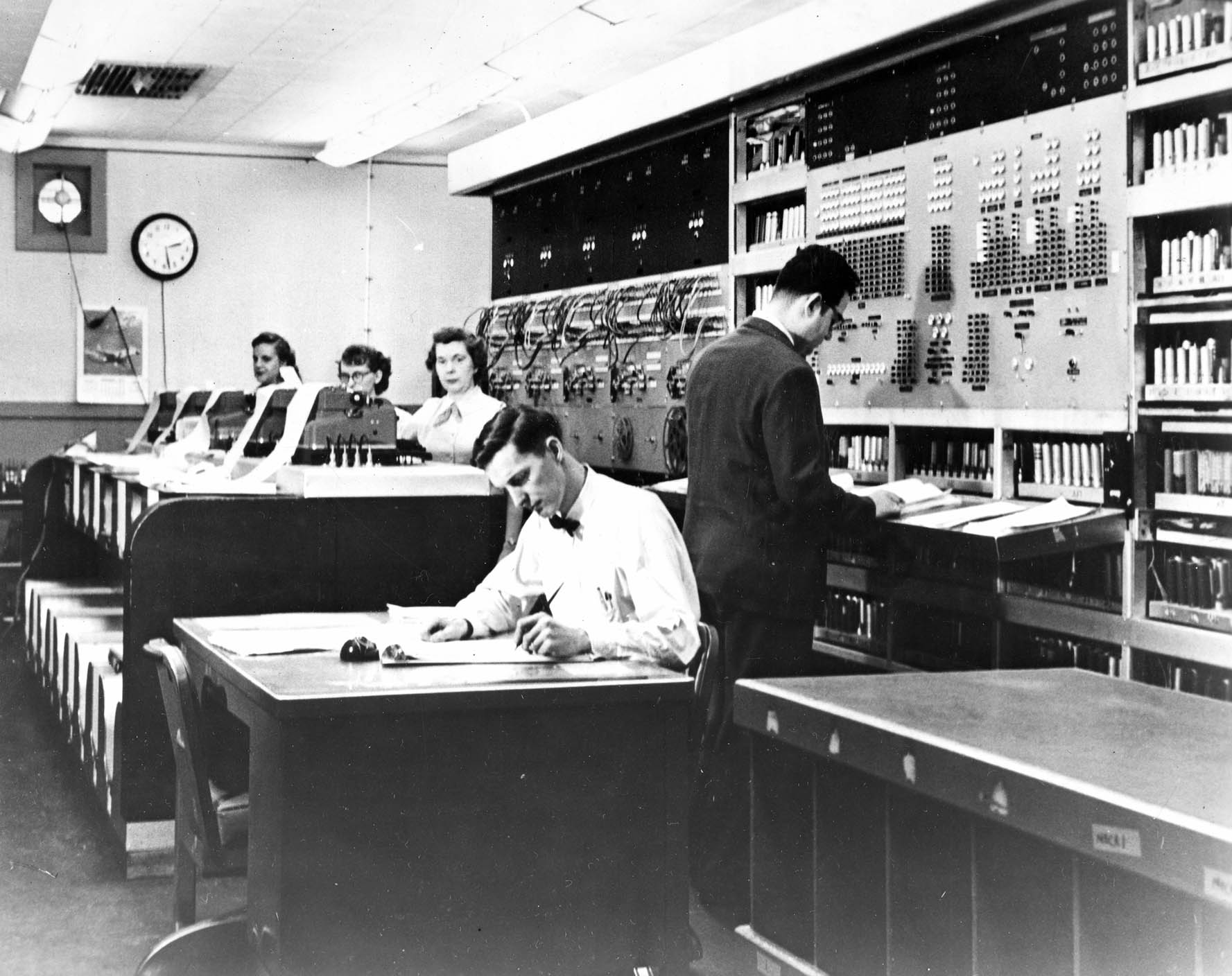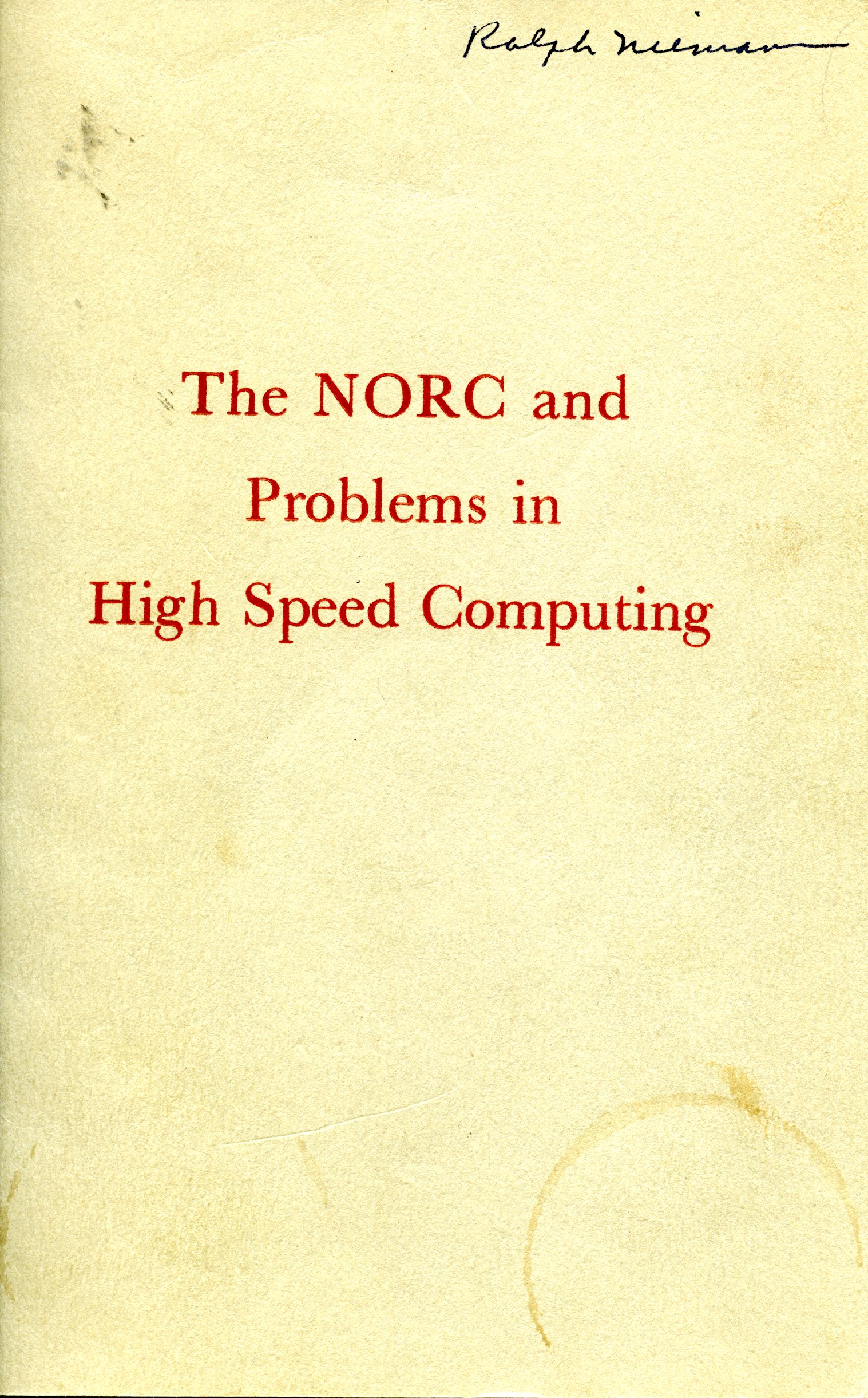
The Naval Ordnance Research Calculator (NORC)
By Theresa Cramer
Dahlgren once housed the world’s most powerful and fastest computer, the Naval Ordnance Research Calculator (NORC). The NORC was delivered to Dahlgren’s Naval Ordnance Computation Center in 1955 and was effective through the rest of the 1950s and 1960s. According to its developers, “NORC does arithmetic in the same manner as a human. It says ‘9 and 6 are 5 and 1 to carry’—but does it in a millionth of a second.”1 While faster and more powerful computers have been developed, the NORC is still considered the first “supercomputer.”
Early Computers at Dahlgren
Dahlgren’s first computing machines were manual desktop calculators. At the start of WWII, Dahlgren was tasked to create all the range and bombing table computations for Navy guns, unguided rockets, and bombs. The base was not fully equipped for this job; Dahlgren only owned two desktop calculators. Dr. Charles C. Bramble was then brought [in] to develop the Computation and Ballistics Department. Within months of Bramble’s arrival, the new department gained over fifty calculators.2 These new desktop calculators were operated 58 WAVES [Women Accepted for Volunteer Emergency Service].3

AIKEN MARK II Calculator
The Computation and Ballistics Department’s war work showcased the need for a more efficient calculator. In March 1945, the Navy contracted Harvard University to develop a new digital computing machine. This resulted in the arrival of the AIKEN MARK II Calculator three years later.4 Named after its creator, Howard Aiken, this calculator was the first large-scale computer on base.2 The machine could calculate 24 operations a second. Obtaining a computer only increased Dahlgren’s projects and need for a faster machine. To alleviate this pressure, the Computation and Ballistics Department consulted outside entities like MIT, the Harvard Laboratories, Bell Labs, and Dr. Fanonman at Princeton to do calculations.2
Two years later, the MARK III Magnetic Drum Calculator/AIKEN Dahlgren Electronic Calculator arrived on base. The MARK III was Dahlgren’s first electronic calculator, expected to perform 176 more operations a second more than the AIKEN MARK II.3 However, the MARK III had issues: its calculations were not always accurate. Programmers had to code additional mathematic checks, which wasted time.

MARK III Magnetic Drum Calculator
The Need for a Faster Machine
The MARK III’s arrival did not alleviate the demand for a better computer. The Naval Bureau of Ordnance decided to take action and form a committee to survey Navy installations and meet with multiple computer manufacturers. Ultimately, the committee sponsored the development of a new machine designed specifically for the Ordnance Bureau’s needs. IBM [International Business Machines] Corporation was selected to develop the new computer in September 1950. It was created on a cost-plus fixed-fee contract. IBM only earned one dollar for its work on the NORC.5
During these negotiations, the Ordnance Bureau expressed Dahlgren’s reliability issues. The Dahlgren mindset was that current computers were only designed for hardware efficiency and did not have human programmers in mind. The base specifically stated it wanted a self-checking feature in the machine to ultimately save staff time. IBM was first apprehensive about adding this feature. They thought self-checking would require a duplicate hardware, reducing the machine’s reliability. Dahlgren instead proposed adding bit-count checks on transfer numbers that could detect errors with minimal hardware.3 IBM ultimately agreed to design a self-checking machine. Another significant debate was the new machine’s numbering system. Some committee members like Dr. Jon von Neumann of Princeton University favored binary notation. Whereas, others favored a decimal numbering system. IBM and the committee ultimately decided the NORC should compute decimals because they thought it would be easier to spot any mistakes.6
IBM Develops a “Supercomputer”
IBM began working on the NORC in October 1950. Over 40 IBM employees worked on the project. Byron L. Havens, the engineer in charge and project leader developed the majority of NORC’s circuitry. The project’s assistant project leader, William J. Deerhake, was responsible for developing and designing the electrostatic charger. IBM’s Poughkeepsie Laboratory created the eight magnetic tapes units that stored calculation results as well as the machine that transferred the tapes into punch cards. IBM Endicott worked on the cover design and printing engineering. Other team members developed NORC’s logic, controls, mechanical design, electrostatic memory, power supplies, register display, and design manual. The NORC was assembled by IBM’s Watson Scientific Computing Laboratory at Columbia University.7
On 2 December 1954, IBM publicly demonstrated the NORC to 150 representatives from the Navy, other federal agencies, and the science and technology fields. Thomas J. Watson Jr., president of IBM then presented the NORC to CAPT C.K. Bergin, Assistant Chief of Research and Development, Naval Bureau of Ordnance.8 This new computer was unlike any other. The NORC could solve a problem with two additions plus one multiplication in 67 microseconds.9 The same calculations took the MARK III 7,100 microseconds and the AIKEN MARK II 83,000 microseconds. Records were printed at 17,000 characters a minute, a task that took 70 typists to complete.1 Years later, IBM called NORC the first “supercomputer.”

Program from the NORC Demonstration
The NORC Reports for Duty
The NORC was originally designated for the Naval Ordnance Laboratory at White Oak. Eight months before the computer’s debut the Ordnance Bureau decided to send it to Dahlgren.6 In March 1955, the NORC was disassembled, packed into 17 trucks, and shipped to Virginia. A team of 12 IBM, and 23 Dahlgren employees reassembled the calculator, though the machine was not fully operation until July 1956.10
While the NORC was being installed, mathematicians like Gladys West were still checking computations by hand with a Marchant Calculator. West became one of the NORC’s programmers. No longer did mathematicians have to check every computation by hand. Instead, they learned how to program and code scientific algorithms. In a 2011 interview, West recalled the excitement staff felt after the new supercomputer was installed. “That was the biggest computer in the Navy at the time that they installed, so that was exciting because it was so fast and you could code so much larger programs, you know, we felt the speed.”11
Along with training existing employees, Dahlgren hired new people to work on the NORC. Programmer Daniel T. Green recollected arriving at Dahlgren with 30 programmers who prepped programs for the computer and another 30 people responsible for computer maintenance and operation.12 With an expanded staff and new computer, the Computation and Ballistics Department was ready to use the NORC to its fullest ability.

The NORC in 1955
The NORC’s arrival was “one of the turning point in the history of the Laboratory,” according to Dr. Bramble.2 It opened up new projects that earlier would have been too time-consuming or expensive. At the height of its use, the computer was operating 24 hours, seven days a week. The NORC developed calculations for a variety of Dahlgren projects, including spotting doctrines for Navy Gun Fire, the Fleet Ballistic Missile Program, amphibious force simulations, war gaming, and optimizing air points for the Polaris A-1 missile. Dahlgren’s new computer was also used for government projects outside of the Department of Defense. Daniel Green’s first project at Dahlgren was creating a random number generator and tracking land ownership for the Bureau of Indian Affairs.12 One of the NORC’s most notable projects was calculating Earth’s orbit from 1920–2000. Dr. Paul Herget, Director of the Cincinnati Observatory managed the project, and Office of Naval Research and the National Science Foundation sponsored it. In a May 1956 statement, Dr. Herget praised the NORC. “We used nine hours of running time and completed more computations than had ever before been done at one time in the history of astronomy."5

Dahlgren Layout of the NORC
Out-powered
Even the world’s most powerful computer could not keep up with Dahlgren’s increased workload. The Computation Center later added two IBM 7090 computers to assist the NORC, but demands for more efficient machines grew. The Navy began negotiations with IBM to deliver the STRETCH Computer (IBM 7030) in 1960. This new calculator performed 285,000 more operations a second than the NORC.13 While computer technology has expanded over the years, the NORC’s arrival at Dahlgren marked a major turning point in the base’s history. Dahlgren’s access to the world’s fastest computer made it easier to do more complex calculations and think on a bigger scale.
1 “NORC Booklet,” IBM Archive, IBM, http://www-03.ibm.com/ibm/history/exhibits/norc/norc_booklet.html.
2 Dr. Charles Bramble Interview with Cynthia Rouse.
3 “Dahlgren’s Contributions to Computing and Computers,” 9 August, 2011.
4 F.W. Dresch, “Brief History of the Dahlgren Calculators,” 1955.
5. “IBM’s NORC: Naval Ordnance,” IBM Archives, IBM, http://www-03.ibm.com/ibm /history/exhibits /norc/.
6. Harry Polachek Interview with Richard R. Mertz, 24 March, 1970, Archives Center, National Museum of American
History, http://amhistory.si.edu/archives/AC0196_pola700324.pdf.
7. “NORC Team,” IBM Archives, IBM, https://www-03.ibm.com/ibm/history/exhibits/norc/norc_team.html.
8. “NORC Press Release,” IBM Archives, IBM, https://www-03.ibm.com/ibm/history/exhibits/norc/norc_team.html.
9. “Naval Ordnance Computation Center U.S. Navy Proving Ground: Dahlgren, Virginia,” NAVORD Report 4866. July
1955.
10. “NORC Chronology,” IBM Archives, IBM, http://www-03.ibm.com/ibm/history/exhibits/norc/norc_chronology.
11. Gladys West Interview with Amelia Toms, 25 April, 2011.
12 Daniel T. Green Interview with Warren Harman, 17 October, 2014.
13. “NSWC Mainframes,” 1992.